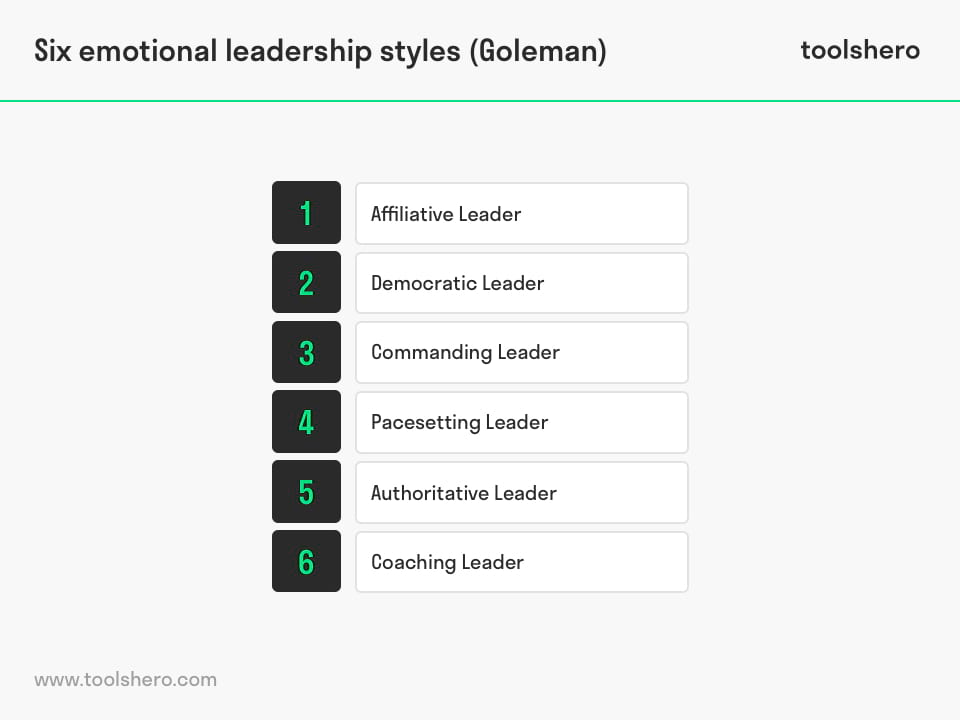Goleman Leadership Styles

Goleman Leadership Styles: this article describes the Goleman Leadership Styles, also know as the Six Emotional Leadership Styles, in a practical way. These styles have been developed by Daniel Goleman. After reading you will understand the basics of this leadership model.
What are the Daniel Goleman Leadership Styles?
The Goleman Leadership Styles (or the six emotional leadership styles) are styles that leaders can take to make sure of a healthy working environment.
According to the Goleman Leadership Styles model, leaders should have the ability to deal with the changing environment on the work floor. The model is for this reason associated with emotional intelligence, a term created by Peter Salovey and John Mayer, but Daniel Goleman popularized it.
Emotional intelligence is the ability to recognize and understand personal emotions and know how these influence the emotions of other people. His explanation of his research into emotional intelligence is more in detail described in his book ‘Working With Emotional Intelligence.’
Since leaders deal with different emotions of employees, they should be able to understand the emotions of others and know how to deal with these emotions so that a positive ambiance on the work floor will be created. If a leader can effectively apply Daniel Goleman’s Leadership Styles in the right situations, they will be more effective in changing to changing environments.
According to the Goleman Leadership Styles, every style has a different impact on the team of an organization. Therefore, it is essential to understand that there is not a right or wrong leadership style. A leadership style of the Goleman Leadership Styles can work excellent for a particular situation, but it might work horribly in another case. The leader must possess the knowledge to understand the leadership styles and have the capability to perform the right leadership style.
The six Goleman Leadership Styles are as follows and will be more described in the next section of this article: The Affiliative Leader, The Democratic Leader, The Commanding Leader, The Pacesetting Leader, The Authoritative Leader, The Coaching Leader.
The Goleman Leadership Styles explained
1. The Affiliative Leader
This type of the Goleman Leadership Styles is concerned with harmonizing the team when there is a negative ambiance. In this leadership style, the leader tries to solve conflicts within the group by attempting to make them collaborate.
The goal of the affiliative leader is to create a team where everyone feels valued and feels part of the team. It for this reason essential to put the team in the first place.
The best moment to utilize this approach is, for example, when the desired results of the team are not achieved because of a lack of collaboration. The leader can only do this effectively when he or she understands and value the emotions of others.
In addition, it is the most appropriate style of the six emotional leadership styles that put people first. Therefore, the priority in this role is to maintain and develop positive relationships.
2. The Democratic Leader
This style of the Goleman Leadership Styles appreciates the contributions of every team member, including their participation in decision-making processes. For a leader to act as a democratic leader, he or she must be sure of high employee engagement before this style can be useful.
The democratic leadership style is helpful when a leader is dependent on the team’s expertise. For instance, an executive manager might have to negotiate with various service companies for social media maintenance about fixed contracts so that it will be easier for payrolling.
The manager is in this case dependent on the team’s experience with different social media service companies to find out about their previous work, and the pros and cons of collaborating with various suppliers.
The democratic leader of Daniel Goleman Leadership Styles can use this style best when proactive decisions have to be made. Urgent decisions can typically best be made by management because the team might not be aware of the all necessary information that could influence the decision.
3. The Commanding Leader
The commanding leader of the six emotional leadership styles can also be referred to as the carrot and stick approach. It means that when a leader tells an employee to execute a specific task, it is expected that the employee completes the assignment without asking questions and without complaining.
Many times, when this type of leadership style is utilized, it is only effective for a short period of time. Sometimes leaders must perform their job as the commanding leader because it could be that the previous assignments failed.
Another reason for performing this leadership style of Daniel Goleman Leadership Styles could be because of an urgent organizational transformation for which there is no time for discussion, or when specific procedures must be executed under local rules and regulations.
4. The Pacesetting Leader
This leadership style of the Goleman Leadership Styles is concerned with results and high-quality work. Many times, the leader serves as an example.
The members of a team are next expected to deliver the desired quality of work. Leaders expect the team to work independently and usually only require weekly or monthly updates about the status of a project. Team members are because of their independence expected to deliver excellent results.
Leaders with this leadership style usually work in a highly competent team with team members who are highly engaged. The pacesetting leader of Daniel Goleman Leadership Styles / the six emotional leadership styles utilizes this style to stimulate the group to become more competent in what the team does.
However, it can sometimes cause stress at the work floor because employees might find assignments very complex and time demanding, which could be a challenge with regards to time management.
As a result, there is a chance that employees can get burnouts. For this reason, the pacesetting leadership style is only useful for short periods, and it might only work best with a highly motivated and engaged team.
5. The Authoritative Leader
The authoritative leader style of the Goleman Leadership Styles is continually concerned with positively energizing the team to reach objectives that contribute to achieving organizational goals.
This leadership style is very effective for motivating team members. These types of leaders are frequently inspired because of their experience and contributions to the field.
The authoritative leader many times also identify oneself as the one with the most expertise. It is expected that team members follow the lead of the authoritative leader because he or she will lead the team to the desired organizational results. Another typical characteristic is that these types of leaders show empathy for others and know how to deal with various kinds of emotions.
The leader leads the team in the right direction when this is necessary. The authoritative leader of Daniel Goleman Leadership Styles makes sure that everyone in the group understands what they are working on and what the expected organizational results are.
Therefore, it is the right leadership style for different types of situations. For instance, it can be useful when an organization is changing its way of working or when an enterprise is working towards another goal.
6. The Coaching Leader
This type of leadership style of the Goleman Leadership Styles is concerned with the development of team members. The coaching leader attempt to identify the strengths and weaknesses of employees and encourage them to improve their skills and capabilities.
This leadership style is therefore mostly concerned with the long-term goal of the organization, and how employees can contribute to achieving these goals.
The coaching leader of the six emotional leadership styles, many times, causes a great place to work where everyone feels valued and where everyone is connected. Employees can be vulnerable, which leads to the rapid advancement of their skills.
This leadership style works best when the team members understand their weaknesses and when they are open to improving those. In the long-run, the weaknesses will be improved, and at the same time, the strengths are further enhanced. As a consequence, the team becomes continually more competent.
In order to be effective in the coaching leadership style of Daniel Goleman’s Leadership Styles, leaders should have frequent conversations with team members to identify which setbacks they are experiencing and how the leader can contribute to helping the team members develop.
Goleman Leadership Styles summary
Although there are six emotional leadership styles, every style of Daniel Goleman’s Leadership Styles has a different effect on people that are being led. It is up to the leader to decide which style works best in a situation.
It is important to note that the most effective leadership style is when the styles are being combined and adjusted to the situation. It means that a leader can have multiple emotional leadership styles. In the end, they are responsible for creating a great working environment.
It’s Your Turn
What do you think? Which leadership style of Daniel Goleman’s Leadership Styles do you prefer? How do you communicate work in your organization? Do you have a team that provides excellent work continually, or do you need to guide your team frequently? What factors are according to you important to determine which leadership style or combination of leadership style is most effective?
Share your experience and knowledge in the comments box below.
More information
- Arond-Thomas, M. (2004). Resilient leadership for challenging times. Physician executive, 30(4), 18.
- Dijk, C. F. V., & Freedman, J. (2007). Differentiating emotional intelligence in leadership. Journal of Leadership Studies, 1(2), 8-20.
- Dulewicz, V., & Higgs, M. (2005). Assessing leadership styles and organisational context. Journal of Managerial Psychology, 20(2), 105-123.
- Gardner, L., & Stough, C. (2002). Examining the relationship between leadership and emotional intelligence in senior level managers. Leadership & organization development journal, 23(2), 68-78.
- Goleman, D. (2000). Leadership that gets results. Harvard business review, 78(2), 4-17.
- Leban, W., & Zulauf, C. (2004). Linking emotional intelligence abilities and transformational leadership styles. Leadership & Organization Development Journal, 25(7), 554-564.
- Lowman, E., & Thomas, R. E. (2015). Emotional Intelligence in the Leadership Framework. Leadership & Organizational Management Journal, 2015(2).
- Preston, G., Moon, J., Simon, R., Allen, S., & Kossi, E. (2015). The relevance of emotional intelligence in project leadership. Journal of Information Technology and Economic Development, 6(1), 16.
- Vidic, Z., Burton, D., South, G., Pickering, A. M., & Start, A. (2016). Emotional and motivational correlates of leadership styles: A comprehensive framework for understanding effective leaders. Journal of Leadership Studies, 10(3), 22-40.
How to cite this article:
Zeeman, A. (2019). Goleman Leadership Styles. Retrieved [insert date] from toolshero: https://www.toolshero.com/leadership/goleman-leadership-styles/
Original publication date: 17/12/2019 | Last update: 08/22/2023
Add a link to this page on your website:
<a href=”https://www.toolshero.com/leadership/goleman-leadership-styles/”>toolshero: Goleman Leadership Styles</a>













